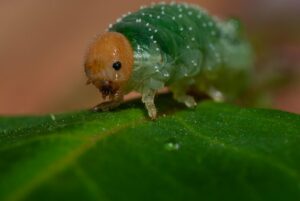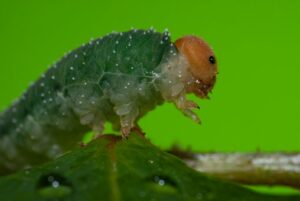How to Control Rose Sawfly

There are about 50 plus species of roses that range in so many colors, sizes, and shapes, most rose species are native to Asia while a smaller number are native to Europe, North America, and northwestern Africa. A rose is a woody perennial flowering plant of the genus Rosa, in the family Rosaceae.
These flowering shrubs are cultivated as cut flowers, for rose water, roses are used widely in many garden and landscape designs, to make essential oils and so much more. But for our roses to thrive, we must ensure they’re taken well care of, besides the right planting location, soil type, watering, and fertilizing methods there is the challenge of the many insect pests that pay our garden a visit.
Once pests in particular we will be turning our attention to is the rose sawfly larvae that can reduce our rose shrubs from a healthy beautiful plant to a plant that’s far from healthy-looking.
How to Identify Rose Sawfly and Slugs
The sawfly is most active during the months of May and June, the adult female rose sawfly deposits her eggs on the leaves’ undersides or inserts her eggs in the margin of the rose leaf. The eggs hatch between mid-April to early May. Once the eggs hatch the larvae will feed for about a month and then drop into the soil and pupate. The larvae of the rose sawfly are yellow-greenish,
Rose Sawfly Lifecycle
There are 4 stages of the rose sawfly, egg, larva, pupa, and adult, once the larvae hatch they go through 5 increasingly larger instars (growth stages).
Rose Sawfly/ Rose Slug Damage
Signs of these garden pests include skeletonized leaves that have ragged holes, which means the larvae are feeding,
4 Ways to Control Rose Sawfly

1. Beneficial Insects
Beneficial insects are a great way to control rose slugs, these beneficial insects can be brought online, if you decide to use beneficial insects to bring control avoid the use of chemicals. These insects include predatory beetles and parasitic wasps, the ideal time to release them in your garden is during the evening hours before the sun sets that way they will settle. Don’t release them during the early morning hours or the afternoon because there is a great chance they may move to your neighbor’s garden or a garden nearby.
2. Using Water
Inspect your rose bush, once the slugs are spotted, knock them to the ground with a strong spray of water from your garden hose, if birds are present in your garden will eat them.
3. The Use of Insecticides
The use of Chemicals will bring a quick know down of these garden pests, but a word of caution, when using pesticides always start with the least toxic because what you don’t want is to use pesticides that are harmful to humans, pets, beneficial insects and wildlife. A great choice would use organic pesticides.
Even then when using organic pesticides caution should be taken, though it may be a challenge to try to protect beneficial insects from coming in contact with these chemicals. One way to do this is to spray roses early in the morning when beneficial insects are least active.
Do not apply chemicals on rainy or windy days or if rain is forecast, before applying chemicals read and follow the manufacturer’s directions for the best results. Pesticides to consider using are neem oil, horticultural oil, or insecticidal soap.
4. Hand Picking Them
Hand-picking rose slugs is an effective and safe way to reduce their population without the use of harmful chemicals, inspect the undersides of your rose’s leaves. You may want to do this on a regular basis, once spotted remove and place larvae in a container of soapy water that will bring elimination.
Creating a Predator-Friendly Environment to Control Rose sawfly
As mentioned earlier the presence of birds will help to bring rose sawfly control, to do this ensure your garden or landscape includes shrubs and trees. Birds love to visit and hang around gardens of this sort because the shrubs and trees act as a cover for them to be protected from the elements ( the sun, wind, and rain).
These covers can also help to camouflage them as they seek out a food source (insects), adding a bird bath will not only attract their presence to your garden but will also encourage them to stay. Birds love to take a bath and also to take a drink, especially during the summer months.
Bonus Points for Rose Sawfly Control
1. The larvae of the rose sawfly can only pupate as they fall to the soil, keeping the soil around your rose bush lightly cultivated will not only keep exposing the sawfly to the elements but to birds that are their predators.
2. Become proactive by applying systemic insecticides to the soil in early to mid-spring, this move can help to discourage the spread of rose sawfly infestations. Word of caution here, the downside is that beneficial insects may come in contact and be harmed by these types of pesticides. Systemic pesticides once applied are taken up by the plant’s roots and translocated through the plant’s entire vascular system, insects that feed on these plants ingest this poisonous chemical which in turn eliminates them.
The final word on rose sawfly control
Roses are beautiful shrubby flowering plants, that should display their beauty, we cannot allow these garden pests to turn our dream rose bush into a nightmare. If you are among the homeowners that may have this issue then following this guide will bring you much success as your hibiscus bounces back to its former glory with its healthy green leaves and beautiful flower display.
About the author
Norman loves being in the garden, both at home and for his job....
he is 'Natures Little helper' being outdoors, growing his vegetables and flowers from an early age.
Now having spent over 22 years in the profession he want to give some of his knowledge to others...
his vast array of hints and tips you will find scattered over this site will help you no end growing plants in your garden.
